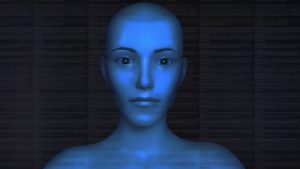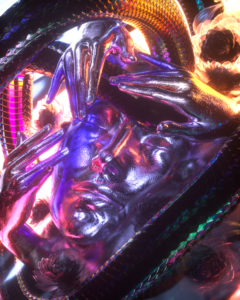David Cash: Hello, everybody. Welcome back to NFTS.WTF, my name’s David Cash, your editor-in-chief, and we’re here live at NFC Lisbon. It’s been a great week and now we’re wrapping up our time here. But before we ended, we had to chat with Colleen Cash, potentially a long-lost relative of mine, who knows? But definitely one of the people leading things at Artnet and doing some amazing things in the NFT space and the traditional art space, helping bridge that gap. Thanks so much for taking the time here. Do you want to give people just a little bit of an idea of your background and why you’re at this NFC conference right now?
Colleen Cash: Thank you, David. So I come from the traditional brick-and-mortar auction space. I used to work at Christie’s. I joined Artnet in 2018 specifically to enter the online game, having no real idea that we would be in this universe, metaverse, whatever. So we do about $30 million a year in traditional fine art across prints, multiples, photographs and contemporary art. And we launched our fully on-chain crypto native NFT marketplace in December 2021.
DC: Ah, Congrats!
CC: Thank you. One is sort of looking at super OG historical NFTs, one with a deep dive into rare Pepes. It’s been an amazing experience. We are really just trying. I mean, everyone says we’re a bridge, but we really are. And our debt is in a unique position to provide context, whether it’s data or news or even just the opportunity to transact for those that otherwise might not be engaging with space.
DC: 100% There are so many things I want to dive into, but I think one thing that’s worth mentioning is, you know, our audience, is very crypto savvy, a lot of collectors. And when you look at the recent history of art Artnet and sites such as Artnet were really the secondary market for a long time, at least the online secondary market pretty much entirely for the last couple of decades and now in NFT space. I think this is something that’s already quite native to Artnet and your team. But how is that transition been and what was the moment that you collectively made that jump into, “Okay, we should actually start tokenizing this digital art.”
CC: Absolutely. So our Artnet is a 33-year-old company founded in 1989 with the Artnet price database. That’s sort of the core Premier product and it was a tough goal back then to convince people that we wanted transparency in the market. We wanted to know what things were trading for. So in a lot of ways, the blockchain, the main net, and the transparency spoke very much to our DNA. And we said it makes a lot of sense that we would be engaging in this both from a context perspective and from a data perspective. So now we’re putting NFTs on the price database. Creators, I think, have really found that meaningful because all of a sudden their auction records are alongside Picassos and Warhols and all of the greatest traditional artists. So what we’ve done is we’re being bold in expanding sort of the canon of art history to include NFT artists and creators. And likewise, as someone who works in the secondary market, I usually work with dead artists. So all of a sudden to be able to work with creators and realize their process, their project, sort of the creator as a market maker. Now, where before you had external people controlling the spigot of their market.
DC: It’s no longer an AMM, it’s like a manual market maker. I don’t know.
CC: Exactly.
DC: Amazing. I’m really excited to see how you continue to progress in this space, especially through Artnet. And also I feel like there’s a two-prong kind of approach. And correct me if I’m wrong, but I’d love to hear your thoughts on this. There are onboarding artists into the NFT space. In your case, I’m sure many of them are already at least digitally conscious, if not digitally native. But then at the same time, what I’m really excited about, that you mentioned, is bringing the NFT crowd into the traditional art collector market and the fact that you’re championing Rare Pepes and OG NFT artists right off the bat. I think it’s super cool. So I’d love to hear how you pitched that to Artnet and what their first thoughts were when you were like, Rare Pepes, let’s go.
CC: It’s so funny. My first strategy with NFTs was to wait, right? January 2021. In spring 2021, everyone was getting involved–
DC: And really rushed.
CC: Rushed and not authentic. So I said until we can have an Onchain platform that’s in ETH that speaks to the community, I don’t want to do it because it wasn’t real.
DC: Thank you.
CC: Thank you for embracing us. Because we were honest and we went to the market to some real thought leaders and Mavericks, and we said, we know nothing in a very honest way. And we said, teach us, what should we do? What advice can you give? What would you like? What would be meaningful? Because we realize our position as a curated platform is in some ways understandably antithetical to DeFi, right? Why do we exist? We have fee structures. We’re gatekeepers. Yes. But we’re also context providers. And that’s what’s so interesting. So when we’re working with artists who are getting into the NFC space, or likewise people in the crypto world, coming into the traditional space, we have to remember this is a period of transformative wealth, unlike anything we’ve ever seen before. Crypto billionaires have homes, too. They have big walls to fill in. And sure, put up an NFT on one wall. But why not engage in another way?
DC: You might want to Damian Hearst or a Worhall or something.
CC: Yeah, right. So for our Rare Pepes sale, we did something interesting where we had a brand new fake rare made exclusively for the sale. And we actually sold the original canvas as well. So we’re putting the two together and say, look at the conversation they have one begets the other.
CC: You said gatekeeper. But honestly, I don’t think it’s quite there for Artnet, at least, because I think that Artnet was also one of those places where, as you said, the secondary market artists could upload their own work. Is it a featured collection? Is it one of your curated drops? Not necessarily, but the egalitarian aspect that people can enter on their own. I feel like it’s already very native and true to this space.
CC: Absolutely. And to art that, I mean, really, our founders’ vision was to democratize the art world. He saw the high barriers to entry at Christie’s and Sotheby’s.
DC: I mean, I mentioned it a lot, but the fact that we use Botalaire 1800s reference points in our commerce today.
CC: Exactly, we’ve been disrupting, and everyone’s a disruptor, especially in the crypto world. But truly, in a previous time, you can only buy a print or a multiple, two times a year at a big house. We have them 24/7. So we’ve always been engaged in this idea of creating access, creating liquidity, and creating opportunity for artists, creators, collectors, and the trade alike.
DC: Super exciting. So what’s next, from your perspective? Are you really trying to push artists forward? Are you trying to bring more people onto the platform? Are you developing a new collector base? What’s kind of your like, I don’t want to say KPI, because we’re not going to be so corporate here. But what’s your vision right now as far as your goal in the space?
CC: Absolutely. It’s a good question. I am being open to the space, right. I’m really trying to engage in an open conversation. So I don’t know what our next sale will be, but I can tell you that conversion is really important to us. We want to help people get into the water. The water is fine. You just have to get comfortable with these operational ideas. Things like fiat onramps help and custodial wallets help. But really, we want to leverage the power of Artnet and sort of the gulf stream of eyeballs and context we have to help people jump into the pool because the water is pretty fun.
DC: That’s beautiful. The last thing I want to leave with, we talk a lot about contextualization. We talk about adding value to artists in the process. But I feel like really the value is coming for the collector. If you can take a process that’s really antiquated and very difficult and simplify that for somebody, build it and they will come. And I feel like that’s really what’s happening. So I love the fact that you’re stepping back and listening as your first response to the space, but even more so, I really love that. Now once you’ve already had a couple of successful collections, you’re still open and you’re still looking and you’re still looking forward because a lot of people, especially now they’ve gotten into the NFT space and they’re kind of like, okay, we did NFTs and now we have NFTs exactly. But the spaces. I talk about hypermodernity and the fact that we’re evolving so rapidly and everything changes every day. So I’m really excited to hear that that’s your perspective and I can’t wait to see what you keep doing.
CC: Constant evolution. That’s the name of the game. Look at how far the industry has come in 16 months. Who knows what the next 16 months will bring but excited to be in it together with you, David.
DC: Amazing just for anybody who is new to you and all the work you do. Work and they find you and Artnet’s NFT drops.
CC: You can find me at Colleen Cash on Twitter or you can find me at Artnet.com/auctions.
DC: Beautiful. Thank you so much for taking the time. Such a pleasure. We’re here at NFC Lisbon. Thank you so much for watching. This is NFTS.WTF, my name is David cash. Thank you again.



